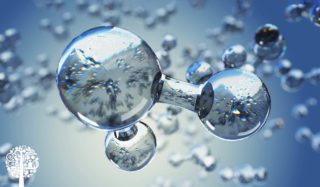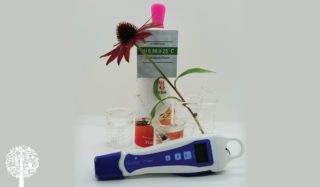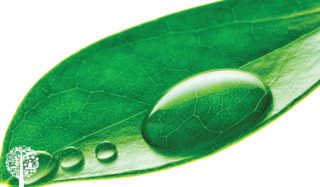Water, Water Everywhere
Earth has a lot of water. Ocean water covers about 71% of the Earth’s surface and makes up a whopping 97% of all the planet’s water. Oceans are salty, though, and of limited use outside of ocean biomes. Freshwater, required by land-dwelling organisms (and those that live in lakes, rivers, and streams), is a different story, making up only about 3% of all the water on Earth. Of that 3%, most is frozen in ice pack and glaciers and is not readily available.
We are lucky to have so much liquid water. Earth is in a planetary Goldilocks Zone, just the right distance from the sun. The temperature is not so high that it boils our water away, not so low as to freeze it all, but just right to keep it mainly in the liquid state.
Of course, all living things require water. Plants need water to create turgor pressure in their cells to keep them erect. Water is also a critical reagent in photosynthesis, where it is oxidized and split to create the gaseous oxygen that is released for us animals to breathe. Given its importance not only for living systems but for many human pursuits, water is one of the most studied and well-understood substances.
The Structure of Water
The chemical formula for water is H2O but don’t be fooled by its apparent simplicity. There is something about the way those three atoms combine that gives water special properties.
A water molecule is bent, with the two hydrogen atoms separated by a bond angle of 104.5° (Figure 1a). Why is a water molecule not linear like carbon dioxide, consisting of three atoms (Figure 1b)? It has to do with electrons, the negatively charged subatomic particles that orbit the positively charged nuclei of all atoms. It is energetically favorable for atoms to be surrounded by either two or eight electrons (the octet rule). We find hydrogen naturally in the diatomic state (H2). Since a hydrogen atom consists of one proton and one electron, two come together to share their electrons, so they “feel” like they have two electrons between them (sorry for anthropomorphizing). We find oxygen (O2) and chlorine (Cl2) in the diatomic state for similar reasons, although they like the number eight instead of two. In water, the number of electrons around the oxygen atom is eight, with one oxygen electron shared with each of the hydrogen atoms (that’s two pairs, four electrons). Oxygen’s other four electrons are arranged in pairs on the other side of the oxygen atom. The negatively charged electron pairs repel each other, pushing each other apart as far as the hydrogens and their electronic bonds allow. This forces the hydrogens closer together, creating the aforementioned bond angle of 104.5°.
Polarity
These two pairs of electrons that hang out on one side of a water molecule create a region that is more negatively charged than the side of the molecule where the hydrogens are. Since the bonding electrons that keep the hydrogens linked to the oxygen tend to be between the oxygen and hydrogen atoms, the positively charged protons of the hydrogen nuclei are somewhat exposed on the other side, making that part of the molecule slightly positive. A water molecule is electrically neutral, but the charge is not distributed equally. Thus, we say that water is “polarised.” And what an effect this polarity has.
The negatively charged side of one water molecule is attracted to the positively charged side of another in a phenomenon called hydrogen bonding. This gives rise to a kind of microscopic structure. However, it is constantly in flux as water molecules weakly link together only to break apart and form links to other molecules as they all spin and vibrate together. This self stickiness can be directly observed as surface tension, a kind of “skin” on the surface of a body of water. It can also be seen in capillary action, the tendency of water molecules to collectively crawl up a glass surface for a short distance or move into a tiny crack in a soil particle. This stickiness helps maintain the transpiration stream in a plant’s xylem tissue; as water flows up toward the stomata, the molecules above provide an electrostatic tug on the ones below.
The polarity of water also contributes to its relatively high boiling point. Water also exists as a liquid over a wide temperature range, and it does not evaporate as fast as less polar substances (such as alcohols) or non-polar compounds such as gasoline.
The Universal Solvent
Water can dissolve more substances than any other liquid, so it is sometimes called the universal solvent. It is especially good at dissolving other polar compounds, which is a source of the old chemistry adage “like dissolves like.” It is not so good at dissolving non-polar substances like fats and oils.
The Colligative Properties of Water
Colligative properties depend on the amount of a substance in a system. Dissolving something in water creates a solution, and the properties of the solution depend on what and how much is dissolved in it. If any substance, salt, for example, is dissolved in water, it lowers the solution freezing point. This is why salt is spread on roads before a winter storm to try and keep them from freezing over as quickly as they otherwise would. In the other direction (even though temperature doesn’t have a direction), boiling points are elevated, meaning that salt water boils at a slightly higher temperature than pure water. Useful to know when cooking pasta.
Acid-Base Behavior
According to the simplest definition (the Arrhenius definition), an acid is a substance that provides H+ ions when dissolved in water, and a base provides OH- ions. So to neutralize an acid (H+), one adds a base (OH-). What do you get when you combine H+ and OH-? Why H2O, of course, which is why water is always a product in any neutralization reaction.
Don’t Take it for Granted
This little collection of three atoms is special. Because of the polarity resulting from how two hydrogen atoms bond to one oxygen atom, water behaves like no other known compound. Until we begin harvesting ice or mining the solar system for it, the water we have is what we’ve got, so we better take good care of it.


